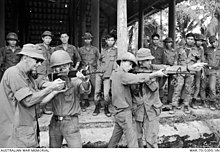
The 1st Commando Regiment is an Australian Army Reserve special forces unit, part of Special Operations Command with an integrated structure of regular (full-time) soldiers and reserve (part-time) soldiers, which together with the full-time Australian Army 2nd Commando Regiment, provides the commando capability to Special Operations Command. 1st and 2nd Commando companies were raised in 1955 and were combined with 126 Signal Squadron (SF) in 1981 to form the 1st Cdo Regt. The regiment's two commando companies are the oldest sub-units within Special Operations Command. In 2008, the regiment deployed to Afghanistan to become the first Australian Army Reserve force element on combat operations since World War II. The regiment is the Command's capability lead for special warfare.
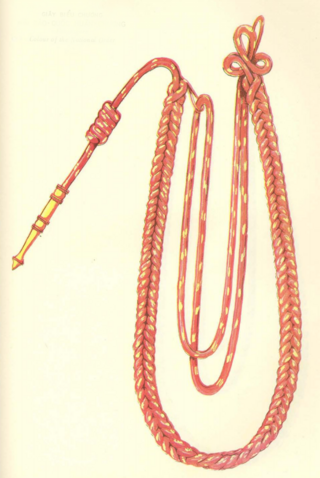
The National Order of Vietnam was a combined military-civilian decoration of South Vietnam and was considered the highest honor that could be bestowed upon an individual by the Republic of Vietnam government.

Peter John Badcoe, was an Australian recipient of the Victoria Cross, the highest award for gallantry in battle that could be awarded at that time to a member of the Australian armed forces. Badcoe, born Peter Badcock, joined the Australian Army in 1950 and graduated from the Officer Cadet School, Portsea, in 1952 as a second lieutenant in the Royal Australian Artillery. A series of regimental postings followed, including a tour in the Federation of Malaya in 1962, during which he spent a week in South Vietnam observing the fighting. During the previous year, Badcock had changed his surname to Badcoe. After another regimental posting, he transferred to the Royal Australian Infantry Corps, and was promoted to major.
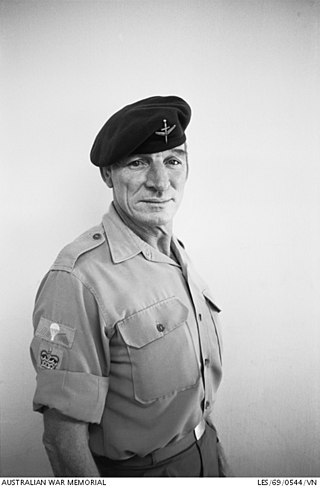
Rayene Stewart Simpson,, was an Australian recipient of the Victoria Cross, the highest award for gallantry "in the face of the enemy" that can be awarded to members of the British and Commonwealth armed forces. Simpson received his award for actions in Kon Tum Province, South Vietnam, on 6 May 1969.

The 1st Australian Task Force was a brigade-sized formation which commanded Australian and New Zealand Army units deployed to South Vietnam between 1966 and 1972. 1 ATF was based in a rubber plantation at Nui Dat, 8 kilometres (5.0 mi) north of Bà Rịa in Phuoc Tuy Province and consisted of two and later three infantry battalions, with armour, aviation, engineers and artillery support. While the task force was primarily responsible for securing Phuoc Tuy Province, its units, and the Task Force Headquarters itself, occasionally deployed outside its Tactical Area of Responsibility.
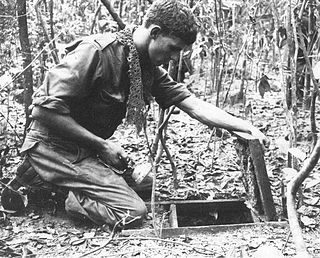
Operation Crimp, also known as the Battle of the Ho Bo Woods, was a joint US-Australian military operation during the Vietnam War, which took place 20 kilometres (12 mi) north of Cu Chi in Binh Duong Province, South Vietnam. The operation targeted a key Viet Cong headquarters that was believed to be concealed underground, and involved two brigades under the command of the US 1st Infantry Division, including the 1st Battalion, Royal Australian Regiment which was attached to the US 173rd Airborne Brigade. Heavy fighting resulted in significant casualties on both sides, but the combined American and Australian force was able to uncover an extensive tunnel network covering more than 200 kilometres, at the cost of 8 Australians and 14 Americans killed and 29 Australians and 76 Americans wounded.

Australia's involvement in the Vietnam War began with a small commitment of 30 military advisors in 1962, and increased over the following decade to a peak of 7,672 Australian personnel following the Menzies Government's April 1965 decision to upgrade its military commitment to South Vietnam's security. By the time the last Australian personnel were withdrawn in 1972, the Vietnam War had become Australia's longest war, eventually being surpassed by Australia's long-term commitment to the War in Afghanistan. It remains Australia's largest force contribution to a foreign conflict since the Second World War, and was also the most controversial military action in Australia since the conscription controversy during World War I. Although initially enjoying broad support due to concerns about the spread of communism in Southeast Asia, an increasingly influential anti-war movement developed, particularly in response to the government's imposition of conscription.
The battle of Nam Đông took place from July 5–6, 1964 during the Vietnam War, when the Viet Cong (VC) and People's Army of Vietnam (PAVN) attacked the Nam Đông CIDG camp in an attempt to overrun it. During the battle, 57 South Vietnamese defenders, two Americans, an Australian Military advisor, and at least 62 attackers were killed.

The Battle of Binh Ba, also known as Operation Hammer, took place during the Vietnam War. The action occurred when Australian Army troops from the 5th Battalion, Royal Australian Regiment fought a combined force of People's Army of Vietnam (PAVN) and Viet Cong (VC), including a company from the PAVN 33rd Regiment and elements of the VC D440 Battalion, in the village of Bình Ba, 5 kilometres (3.1 mi) north of Nui Dat in Phuoc Tuy Province. The battle was unusual in Australian combat experience in South Vietnam as it involved fierce close-quarter house-to-house fighting, although the majority of enemy killed was through heavy artillery and air-bombardment. In response to PAVN/VC attempts to capture Binh Ba the Australians assaulted the village with infantry, armour and helicopter gunships, routing the VC and largely destroying the village itself. Such battles were not the norm in Phuoc Tuy, however, and the heavy losses suffered by the PAVN/VC forced them to temporarily leave the province. Although the Australians did encounter PAVN/VC Main Force units in the years to come, the battle marked the end of such large-scale clashes, and ranks as one of the major Australian victories of the war.

The Battle of Gang Toi was fought during the Vietnam War between Australian troops and the Viet Cong. The battle was one of the first engagements between the two forces during the war and occurred when A Company, 1st Battalion, Royal Australian Regiment struck a Viet Cong bunker system defended by Company 238 in the Gang Toi Hills, in northern Bien Hoa Province. It occurred during a major joint US-Australian operation codenamed Operation Hump, involving the US 173rd Airborne Brigade, to which 1 RAR was attached. During the latter part of the operation an Australian rifle company clashed with an entrenched company-sized Viet Cong force in well-prepared defensive positions. Meanwhile, an American paratroop battalion was also heavily engaged in fighting on the other side of the Song Dong Nai.

Brigadier Francis Philip "Ted" Serong, was a senior officer of the Australian Army. Born into a Roman Catholic family in 1915, Serong's opposition to communism led him to join the army, graduating from the Royal Military College, Duntroon, in 1937. During the Second World War he mainly served in training and staff roles, but saw combat against the Japanese at Wewak late in the war. In the post-war period he had a significant influence on the training of the Australian Army, which he helped re-orient to warfare in South East Asia, heading the jungle training centre at Canungra in 1955 and developing the army's counter-insurgency doctrine. He instructed the armed forces of Burma in jungle warfare in the late 1950s and was a strategic advisor to the Burmese Army from 1960 to 1962.

Lieutenant General Sir Reginald George Pollard, was a senior commander in the Australian Army. He served as Chief of the General Staff from 1960 to 1963.

Major General Stuart Clarence Graham, was a senior officer in the Australian Army, seeing service during the Second World War, the Occupation of Japan and the Vietnam War. Born in Ulmarra, New South Wales, he graduated from the Royal Military College, Duntroon in 1940. Graham subsequently held a series of regimental and staff appointments, serving in a number of infantry and armoured units during the Second World War. In the post-war period he served in the British Commonwealth Occupation Force in Japan, and held a number of staff and command positions in the Armoured Corps. In the late 1950s he was posted to Army Headquarters, and later served as Director of Military Intelligence. Commanding the 1st Australian Task Force during fighting in South Vietnam during 1967, he was responsible for establishing the controversial barrier minefield from Dat Do to the coast. Later, Graham filled a range of senior command, staff and diplomatic roles in Australia and overseas, including the position of Deputy Chief of the General Staff (DCGS), before retiring in 1977. He died in 1996.

Brigadier Oliver David Jackson, was a senior officer in the Australian Army, seeing service during the Second World War and the Vietnam War. After graduating from the Royal Military College, Duntroon, in 1939 he served in the Middle East and New Guinea during the Second World War. Later, he commanded the Australian Army Training Team Vietnam (AATTV) and the Australian Army Force Vietnam (AAFV) in 1965–66. In 1966, he became the first commander of 1st Australian Task Force in South Vietnam. He subsequently filled a number of senior command and staff positions before retiring in 1974. He died in 2004.

The Republic of Vietnam National Police – RVNP, Police Nationale de la République du Vietnam or Police Nationale for short in French, was the official South Vietnamese national police force from 1962 to 1975, operating closely with the Army of the Republic of Vietnam (ARVN) during the Vietnam War.

Major General Douglas (Tim) Vincent, was a senior officer in the Australian Army, seeing active service during the Second World War and the Vietnam War. Graduating from the Royal Military College, Duntroon in 1938 into the Signals Corps, he volunteered for service in the Second Australian Imperial Force soon after the outbreak of the Second World War and served in Syria, Western Europe and Borneo. Later, he served as Commander Australian Force Vietnam (COMAFV) during the Vietnam War. After a number of senior staff positions he retired in 1973. He was actively involved in defence issues in his retirement and served as a chairperson of the Returned and Services League of Australia (RSL) prior to his death.
This is an order of battle listing the Australian and Viet Cong forces involved in the Battle of Long Tan which occurred in Phuoc Tuy Province, South Vietnam on 18 August 1966.

The 1st Australian Civil Affairs Unit was raised in 1967 to coordinate the Australian Army's contribution to the US and allied Pacification Program during the Vietnam War, operating in Phuoc Tuy Province. Although other Australian units also conducted civic action projects in South Vietnam at various times, 1 ACAU had the primary responsibility for them once it was deployed. It was withdrawn from South Vietnam in November 1971.
Major General John Curtis Hartley, is an Australian defence and intelligence strategist and a retired officer of the Australian Army. He joined the army via the Royal Military College, Duntroon in 1962, was commissioned into the Royal Australian Infantry Corps and spent much of his career in military intelligence. He twice deployed on operations during the Vietnam War, during which he was Mentioned in Despatches on two occasions and seriously wounded, and commanded the Albury–Wodonga Military Area and the Army Apprentices' School (1984–87). He served as General Officer Commanding Training Command (1991–92), Director of the Defence Intelligence Organisation (1992–95), Deputy Chief of Army (1995–98), and Land Commander Australia (1998–00). Since his retirement from the army in 2000, Hartley has been involved in community and veterans' organisations and is an active contributor to discussion on defence and strategic issues.
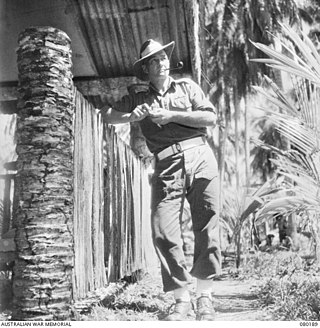
Colonel George Radford Warfe, was an Australian Army officer who commanded several Australian commando and infantry units during the Second World War. He later served in staff and training roles in the post war period, which included service during the Malayan Emergency and then as a civilian advisor during the Vietnam War following his military retirement. He was active in the civil defence organisation in Victoria and in the business community before his death at the age of 63 in November 1975 from cancer.
